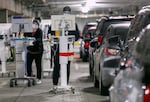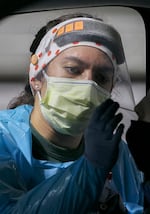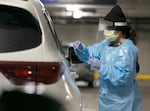
Medical assistant Hunter Hermansen, center, registers people waiting to take a COVID-19 test at OHSU's drive-through testing site at the Oregon Convention Center, November 20, 2020 in Portland, Ore. A recent spike in cases and the upcoming holidays have led to increased wait times at testing facilities.
Kristyna Wentz-Graff / OPB
Massive numbers of Oregonians are trying to get tested for COVID-19 with Thanksgiving now only days away.
There are only two places in the Portland metro area that offer regular drop-in COVID-19 testing: the Oregon Convention Center and Hillsboro Stadium, both run by the Oregon Health and Science University. Wait times at those locations can be hours long.
Among those seeking tests, some have symptoms. Some think they may have been exposed. Other people just want to know if they can see their families for the upcoming holiday. Regardless of the reason, more people are seeking COVID-19 tests than ever before.
“There’s a high degree of anxiety, or a high degree of awareness that we’re in the midst of rising numbers,” said Dr. Lester Baskin, a primary care physician at Baskin Clinic. He’s seen a big uptick in patients trying to confirm that they’re COVID-19 free before getting together with relatives. Many of those patients don’t have COVID-19 symptoms, and haven’t had close contact with a confirmed COVID-19 case.
“It’s been a really common request in our practice and other practices,” Baskin said. “Folks want to get together. They think they’re doing the right thing, getting the test before gathering.”
But that’s the problem, Baskin says: getting that test might not be the right thing to do.
Demand for testing has surged. And while that demand is soaring, hospitals are being forced into tough decisions about how to prioritize.

Medical assistant Anuhea Taum performs a nasal swab on a patient at OHSU’s drive-through COVID-19 testing site at the Oregon Convention Center, Nov. 20, 2020 in Portland, Ore.
Kristyna Wentz-Graff/OPB / OPB
“One of the things we’ve had to navigate is making public health decisions on a daily or weekly basis,” said Dr. Matt Snodgrass, the clinical medical director of Providence’s Progress Ridge clinic and the medical director of the virtual clinic used to triage patients. Snodgrass said his team can pull several types of “surge levers” to handle increased demand. One of those levers includes deciding who can and can’t get a COVID-19 test at Providence locations.
Under the official guidance from the Oregon Health Authority, individuals qualify to get a COVID-19 test if they have symptoms, have had close contact with a confirmed case, or if they suspect they have been exposed to COVID-19 and are in a high-risk group, based on age or medical conditions.
“Currently, the guidelines are pretty broad. You don’t need to have a whole lot of significant symptoms to be eligible for a test,” Snodgrass said.
Triaging testing
But practitioners at Portland-area hospitals, Snodgrass’s included, have had to start discouraging people who don’t strictly meet OHA’s standards, or even turn them away.
“We’re far more limited now in offering testing capacity for people who aren’t sick. We’ve had to turn that lever off and say, ‘Listen, if you’re calling right now and requesting testing and you don’t have symptoms, we don’t have enough resources,’” Snodgrass said. “We need to focus our energies on people who are sick.”
Legacy Health hospitals and clinics are trying to triage this surge before patients even get in the door (or, in this case, the tent). It starts with scheduling.
“We look at our requests, and schedule symptomatic cases first. Then we look at capacity, and schedule high-priority asymptomatic cases,” said Dr. Nick Kashey, the interim clinical vice president for population health at Legacy. Like Providence, Legacy has had to start prioritizing its testing.
“We’re primarily focusing on symptomatic testing, and any asymptomatic folks who meet the OHA high-risk criteria,” he said.
Related: How bad is this COVID-19 third wave?
Right now, Legacy doesn’t offer travel testing because of limited lab capacity. And although many of the supply chain issues that plagued the U.S. earlier on in the pandemic have been solved, there’s one supply we can’t easily make more of: people.
Running tests for COVID-19 requires lab employees and people to administer tests. And adding employees means providing training and developing skills. Kashey said Legacy has contracted with outside healthcare groups to shore up its staffing.
‘Negative test not a free pass’

Medical assistant Danielle Salinas prepares a test at OHSU's drive-through COVID-19 testing site at the Oregon Convention Center, Nov. 20, 2020 in Portland, Ore.
Kristyna Wentz-Graff / OPB
There’s another reason to hold off on getting a test to see if you’re contagious before gathering with others for Thanksgiving. If you’re asymptomatic, there’s every chance a COVID-19 test could miss your infection.
Dr. Dawn Nolt is a professor of pediatric infectious diseases at OHSU Doernbecher Children’s Hospital. A large part of her work involves ensuring that patients with infectious diseases don’t infect anyone else and don’t get new infections while in the hospital. Nolt said, emphatically, that “a negative test is not a free pass.”
People infected with COVID-19 can test negative for a number of reasons. The biggest one is simply time: It takes a while for there to be enough virus in your system for it to show up on a test.
It usually takes at least three days for the COVID-19 virus to replicate itself enough to be detected on laboratory tests. But for many people, the incubation can be even longer: up to 14 days. And some people may never test positive.
That means that if someone was exposed on a Monday, and went to get a test on a Thursday, there’s a chance that the test would be negative, even if they were infected.
People want those tests to feel safe. They want to know that they won’t make their friends and family sick.
“They want to take masks off, or maybe get a little closer to a relative or friend. They want to be reassured,” Nolt said. “But those asymptomatic on-demand tests really don’t assure anyone. They don’t tell you you’re not infected.”
Symptomatic cases usually have higher levels of virus, so they’re less likely to have these false negatives.
Doctors’ plea: Stay home
Managing the public’s desire to be tested is tricky. On the one hand, health care workers don’t want to discourage it. But right now, Nolt said, “Testing supply and testing times are really becoming very precious. We would appeal to people that they only get tested if they are sick or have a public health reason to get tested.”
Had the United States been able to build up its COVID-19 testing capacity since last February, when the coronavirus was first showing up here, testing asymptomatic people might be a more practical option. And that would be a good thing. While a negative test can’t say much, a positive test result can tell public health officials a lot. They can start contact tracing, and the person who tested positive knows to tell their friends and family to quarantine.
But testing capacity is limited. And highly-publicized outbreaks on cruise ships and among those attending mask-free White House events have shown just how easy it is for a virus to slip past the protective net of testing.
Related: Everything you need to know about COVID-19 now that cases are soaring and the ‘freeze’ is here
That’s why Dr. Baskin tries to discourage his patients from visiting family over Thanksgiving, regardless of what their COVID-19 test results are. There’s only one way to be completely sure that you don’t have COVID-19: quarantine.
“Unfortunately, some people may approach that as sort of a quarantine-light, you know?” Baskin said, “But quarantine means isolated — in your house, isolated from other people.”
Quarantine isn’t just about avoiding close contacts: It means avoiding all contacts.
Even after a quarantine, Baskin encourages people to keep using masks and practicing social distancing when meeting with friends. Most people who have COVID-19 will either develop symptoms or test positive within 14 days, but there are always outliers.
Late Friday afternoon, a group of over 750 physicians signed a petition to all Oregonians. They only had one request: Keep hospital beds empty by staying home this Thanksgiving.